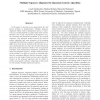294 search results - page 53 / 59 » Predicting the beta-helix fold from protein sequence data |
BMCBI
2004
13 years 7 months ago
2004
Background: The identification of relevant biological features in large and complex datasets is an important step towards gaining insight in the processes underlying the data. Oth...
BMCBI
2006
13 years 7 months ago
2006
Integration of heterogeneous data types is a challenging problem, especially in biology, where the number of databases and data types increase rapidly. Amongst the problems that o...
BIOINFORMATICS
2011
13 years 2 months ago
2011
Motivation: High-throughput methods for detecting molecular interactions have produced large sets of biological network data with much more yet to come. Analogous to sequence alig...
IPPS
2006
IEEE
14 years 1 months ago
2006
IEEE
In this paper we describe a new approach for the well known problem in bioinformatics: Multiple Sequence Alignment (MSA). MSA is fundamental task as it represents an essential pla...
CSB
2005
IEEE
14 years 1 months ago
2005
IEEE
Recently Bowers et al. [1] analyzed triplet logic relationships among 4873 Clusters of Orthologous Groups (COGS) from 67 fully sequenced organisms by calculating how well logic re...

